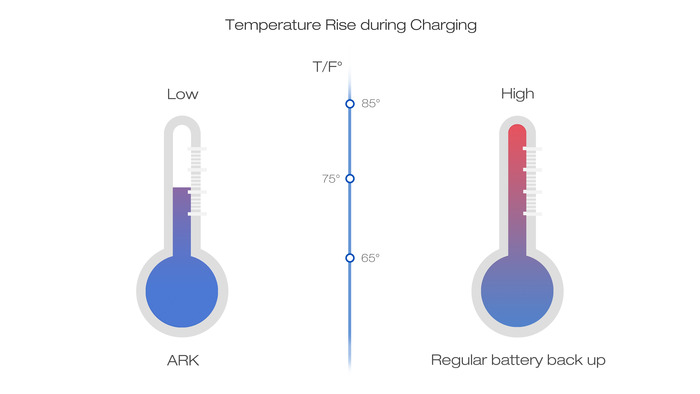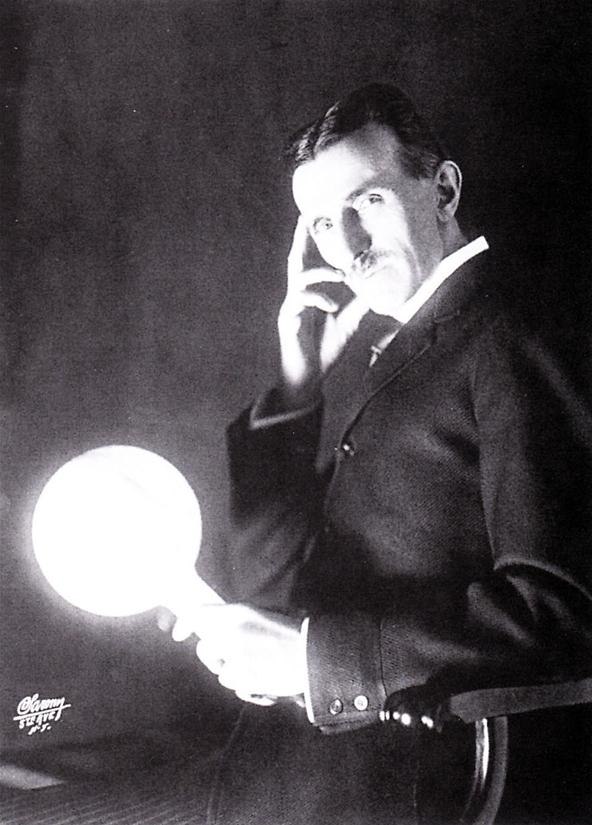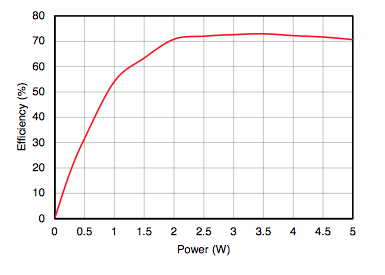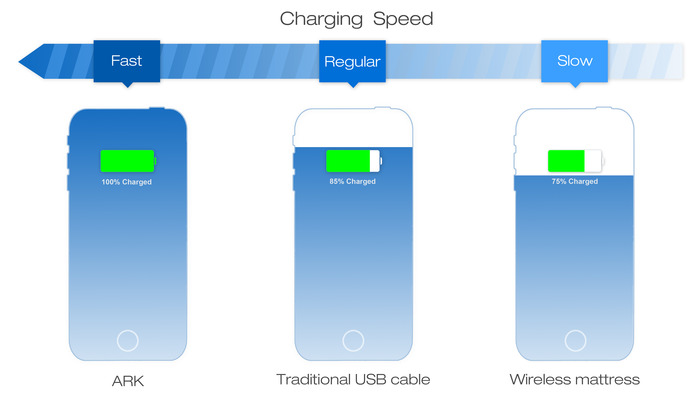As the portable backup battery market is flooded with a number of hand-held battery solutions, the Ark from Bezalel hopes to float above the rest by offering a wireless charging feature uncommon in portable devices. With forty days and forty nights left to go on their campaign, it looks like they’re well on their way to reaching their $35,000 goal, but when their efficiency claims are scrutinized, one wonders why anyone should bother waiting.
Wireless charging
Wireless power transmission has been the dream of electrical engineers and scientists ever since Nikola Tesla played with it in the late 1800s. While Tesla did manage to transfer a few watts wirelessly such as in this famous photo:
He ultimately failed to make wireless power a reality for global distribution.
Many Tesla fanatics claim that wireless power never took off because the power companies couldn’t figure out how to meter and bill for it, but the reality is that it was and continues to be incredibly inefficient. As boring as they may be, the high voltage wires that litter the sky are a super duper effective way of getting energy from A to B.
For less permanent installations however, wireless power has its perks. Just about every rechargeable electric toothbrush uses some kind of wireless charging in the base station to remove the need for metal contacts, and RFID tags use a form of wireless power to juice up a circuit on a card that provides information about the user without requiring a battery.
Unlike Tesla’s dream of transmitting megawatts of energy over the ocean, these modest devices utilize near-field transmission to move just a few watts (if that) over a few centimeters. Cellular phone charging is another great potential application of this technology as many users want quick and convenient access to their phone without fiddling around with cables. Like their cable predecessors though, some of the biggest design challenges have been deciding on a universal standard.
This is why the QI wireless charging standard (pronounced “Chee”) was created. Although this system can only deliver power over distances of 4cm, its 5W throughput is enough to charge a plethora of portable electronic devices, and future specifications may allow for even more power to be transmitted. Unfortunately, similar to Tesla’s dilemma, this system still isn’t as efficient as copper wire.
The BQ500212 from Texas Instruments is a QI certified wireless power transmitter, and even at its best, it only achieves around 73% efficiency.
I could poke around and find more sources like this, but NXP, a major electronic component manufacturer, has a blog post published August of last year that makes my point for me:
During the last decade plug-in chargers have become more and more efficient, keeping overall power consumption to a minimum. Advanced systems, such as those based on the GreenChip IC family, means efficiency during charging has risen to 90% or more, with only a few milliwatts of power lost in standby mode.
By comparison wireless chargers only achieve a typical charging efficiency of around 70%. So charging wirelessly seems to introduce a significant waste of energy.
The post goes on to explain how a lot of the inefficiency can be attributed to limitations in present-day technology or lack of standardization, but the point is that today’s technologies are limited to about 70%. Bezalel can tweak their product all they want, but if they want to transmit power wirelessly, they are going to be throwing away an extra 20% more energy over more conventional chargers.
Dubious claims
Bezalel has made my job easy by providing super detailed graphs:
Apparently they claim that this device can charge your phone faster than a USB cable and any other wireless charger out there. I’m pretty sure that both of these assertions are wrong, and I would love to see more detailed information on their test setup.
Any USB cable is capable of charging any wireless device at its maximum speed; the only thing up for debate is if the power source can provide enough current. The maximum current an iPhone can accept is 1A. It doesn’t matter if you can provide twice that. That’s all it will take. Providing more will not speed things up. This is why Apple’s standard iPhone charger can only provide 1A of current. This and the similar specs of other phones are also why the QI standard is designed to deliver 1A at 5V.
It’s confusing therefore that they claim to charge faster than anything else. I can not think of any explanation for their claims other than poor testing procedures. It looks like they simply charged a phone and recorded how long it took with different power sources. It’s possible that the phone performed more activity during the USB test which drew more power and slowed down charging. They also could have been using a crappy wireless charger or maybe a USB port from a computer that is only rated for 500mA. Or maybe they’re making stuff up.
I would like to see a test where they actually measure the current delivered by a USB cable compared to their charger.
Then there’s this doodle:

Here they claim that they’ve found some way to reduce the waste heat generated during phone charging. Wireless or not, anything pulling large amounts of power out of a battery is going to give off some heat. Adding wireless increases heat even more as 20% of the energy is wasted driving the transmission. Reducing waste heat is not a trivial task in electrical engineering, and a large body of engineers are competing on a global scale to make modest improvements. I find it hard to believe that a couple of people on Kickstarter somehow gave an entire industry the slip.
My explanation here is that the Ark is simply larger than many competing battery supplies on the market, and it looks like it has a lot of empty space on the inside to make room for the wireless transmitter. This air gap may provide insulation that prevents waste heat from making it to the outside where the user would notice it as an increase in temperature. Additionally, its larger size means that the heat is spread out over a larger surface area which will lower the perceived surface temperature. If anything, the lack of effective heat flow may cause the battery to operate at a higher temperature and shorten its lifespan.
Maybe if they were PHDs working at some kind of university I might believe they’ve squeezed out a 1% increase in efficiency using some innovative switch mode power supply topology, but considering they fire off sentences like this:
and their first prototype board looks like it literally caught fire, I like my explanation better.
Precious juice
While an inefficient refrigerator or HVAC system may burn a hole in your wallet, a phone represents an extremely small amount of power usage, so throwing away 20% of your power to add the convenience of wireless charging seems like a pretty good tradeoff. We’re only talking about maybe 0.4kWh of energy per year lost which for most places comes down to less than a dime in cost.
Of course, this is when you have the convenience of a wall socket nearby. While you may be happy to blare the music and crank up the backlight from the comfort of your couch, sitting on a plane you tend to dim the screen and grab some headphones so your battery will make it through that episode of Dawson’s Creek.
Even though battery technology has made major strides over the past decade, there is still no resource more precious to a teen stuck at a family reunion than the charge left in his/her phone. Carrying around a backup battery may mitigate that risk, but it still remains a limited resource that can cost you dearly if it runs out.
That makes one wonder if a battery powered wireless charger is really a good idea. They’re essentially taking a good product, making it less efficient, making it bulkier, and charging more for it. Using this thing involves throwing away energy from your portable battery just so you don’t have to plug in a cable.
With a 5200mAh battery, I’m a little doubtful of their “3 charges with smart phones” spec, but assuming you only need one or two extra charges to get you through your day and don’t want to deal with a cable, I think it’s a decent product.
For anyone else, there are already a number of cheaper and better alternatives out there.









Could the issue be that it vents heat away from the phone (and it’s battery) better? I’ve often wondered if a small air gap between the phone and wireless charger could help with this.